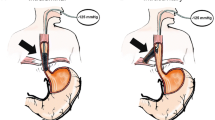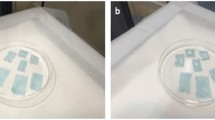Abstract
Background
The aim of this study was to investigate the efficacy of the fibrin tissue patch and to analyze its use in patients with esophageal perforation.
Methods
We studied 28 patients who were diagnosed with esophageal perforation between January 1990 and January 2006 at Akdeniz University Hospital. Sixteen (57.14%) were male. The average age was 59 ± 9 years. We performed surgery and primary repair reinforcement even if the diagnosis of esophageal perforation was late.
Results
Twenty-three (82.14%) perforations were the result of endoscopic instruments; spontaneous perforations occurred in three (10.71%) patients. Postoperative complication (Heller myotomy) caused perforation in one patient (3.57%) and blunt trauma in one patient (3.57%). Three (10.71%) patients had cervical perforation, and 25 (89.29%) patients had thoracic esophageal perforation. Twelve (42.86%) patients underwent emergency surgery (within the first 24 h). Ten (35.71%) patients underwent surgery within 48 h, and the remaining 6 (21.43%) underwent surgery after 48 h. Nine (32.14%) patients had primary repair, 7 (25%) had reinforcement of the primary repair with fibrin tissue patch, 7 (25%) had esophagectomy and gastric pull-up, and 2 (7.14%) had drainage and placement of metallic stents. In four patients of the nine who had primary repair, fistula complication was detected, whereas in only one of the seven who had reinforcement of the primary repair with fibrin tissue patch was a fistula detected. Three patients (10.71%), two of whom had Boerhaave’s syndrome, died.
Conclusions
Surgical primary repair with fibrin tissue patch is the most successful treatment option in the management of esophageal perforation.

Similar content being viewed by others
References
Jones WG, Ginsberg RJ (1992) Esophageal perforation: a continuing challenge. Ann Thorac Surg 53:534–543
Port JL, Kent MS, Korst RJ, et al. (2003) Thoracic esophageal perforations: a decade of experience. Ann Thorac Surg 75:1071–1074
Brinster CJ, Singhal S, Lee L, et al. (2004) Evolving options in the management of esophageal perforation. Ann Thorac Surg 77:1475–1483
Wesdorp IC, Bartelsman JF, Huibregtse K, et al. (1984) Treatment of instrumental esophageal perforation. Gut 25:398–404
Attar S, Hankins JR, Suter CM, et al. (1990) Esophageal perforation: a therapeutic challenge. Ann Thorac Surg 50:45–51
Eroglu A, Kurkcuoglu IC, Karaoglanoglu N, et al. (2004) Esophageal perforation: the importance of early diagnosis and primary repair. Dis Esophagus 17:91–94
Bufkin BL, Miller JI Jr, Mansour KA (1996) Esophageal perforation: emphasis on management. Ann Thorac Surg 61:1447–1452
Flynn AE, Verrier ED, Way LW, et al. (1989) Esophageal perforation. Arch Surg 124:1211–1215
Urschel HC Jr, Razzuk MA, Wood RE, et al. (1974) Improved management of esophageal perforation: exclusion and diversion in continuity. Ann Surg 179:587–591
Johnsson E, Lundell L, Liedman B (2005) Sealing of esophageal perforation or ruptures with expandable metallic stents: a prospective controlled study on treatment efficacy and limitation. Dis Esophagus 18:262–266
Kiernan PD, Sheridan MJ, Hettrick V, et al. (2006) Thoracic esophageal perforation: one surgeon’s experience. Dis Esophagus 19:24–30
Okten I, Cangır AK, Ozdemir N, et al. (2001) Management of esophageal perforation. Surg Today 31:36–39
Chao YK, Liu YH, Ko PJ, et al. (2005) Treatment of esophageal perforation in a referral center in Taiwan. Surg Today 35:828–832
Khan AA, Shah SW, Alam A, et al. (2005) Sixteen years follow up of achalasia: A prospective study of graded dilatation using Rigiflex balloon. Dis Esophagus 18:41–45
Richardson JD (2005) Management of esophageal perforations: the value of aggressive surgical treatment. Am J Surg 190:161–165
Bladergroen MR, Lowe JE, Postlethwait RW (1986) Diagnosis and recommended management of esophageal perforation and rupture. Ann Thorac Surg 42:235–239
Sung SW, Park JJ, Kim YT, et al. (2002) Surgery in thoracic esophageal perforation: primary repair is feasible. Dis Esophagus 15:204–209
Wright CD, Mathisen DJ, Wain JC, et al. (1995) Reinforced primary repair of thoracic esophageal perforation. Ann Thorac Surg 60:245–249
Acknowledgment
The authors thank T.M.P. Duggan for editing the manuscript. This study was supported by the Akdeniz University Research Fund.
Author information
Authors and Affiliations
Corresponding author
Rights and permissions
About this article
Cite this article
Erdogan, A., Gurses, G., Keskin, H. et al. The Sealing Effect of a Fibrin Tissue Patch on the Esophageal Perforation Area in Primary Repair. World J Surg 31, 2199–2203 (2007). https://doi.org/10.1007/s00268-007-9207-z
Received:
Accepted:
Published:
Issue Date:
DOI: https://doi.org/10.1007/s00268-007-9207-z




